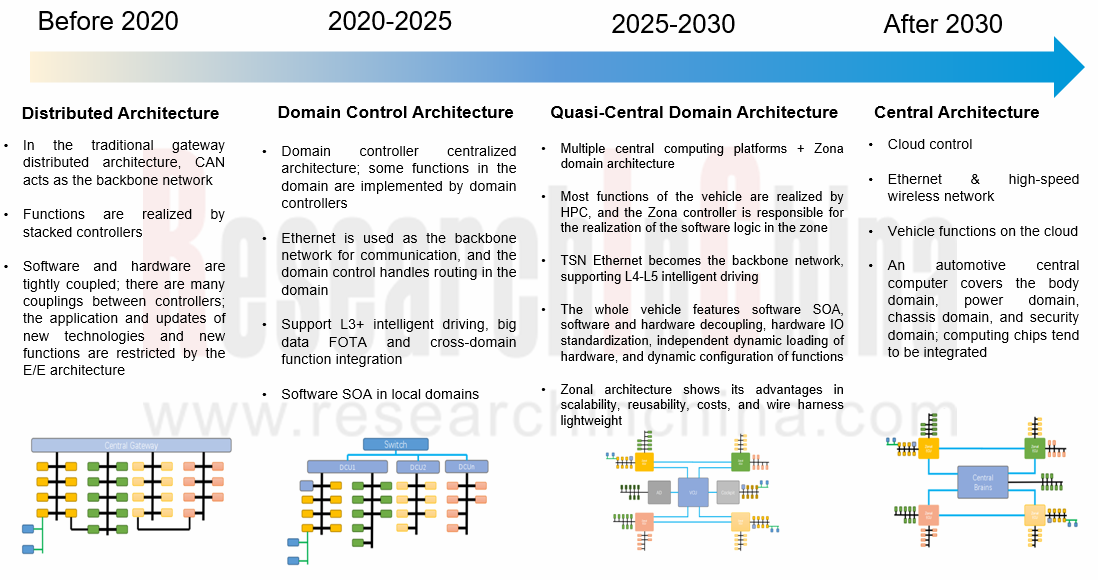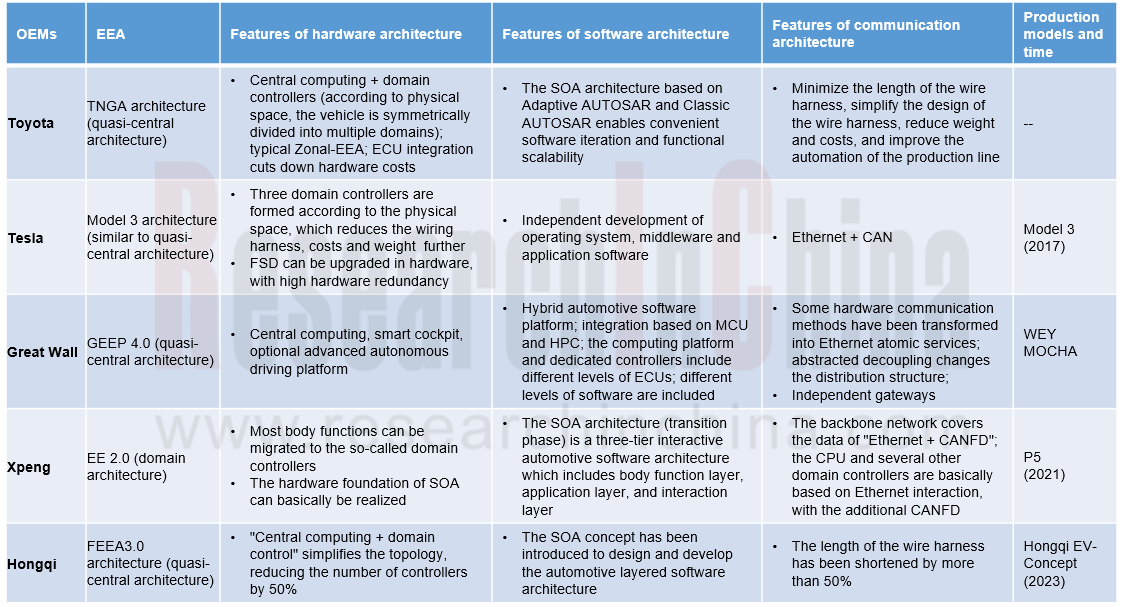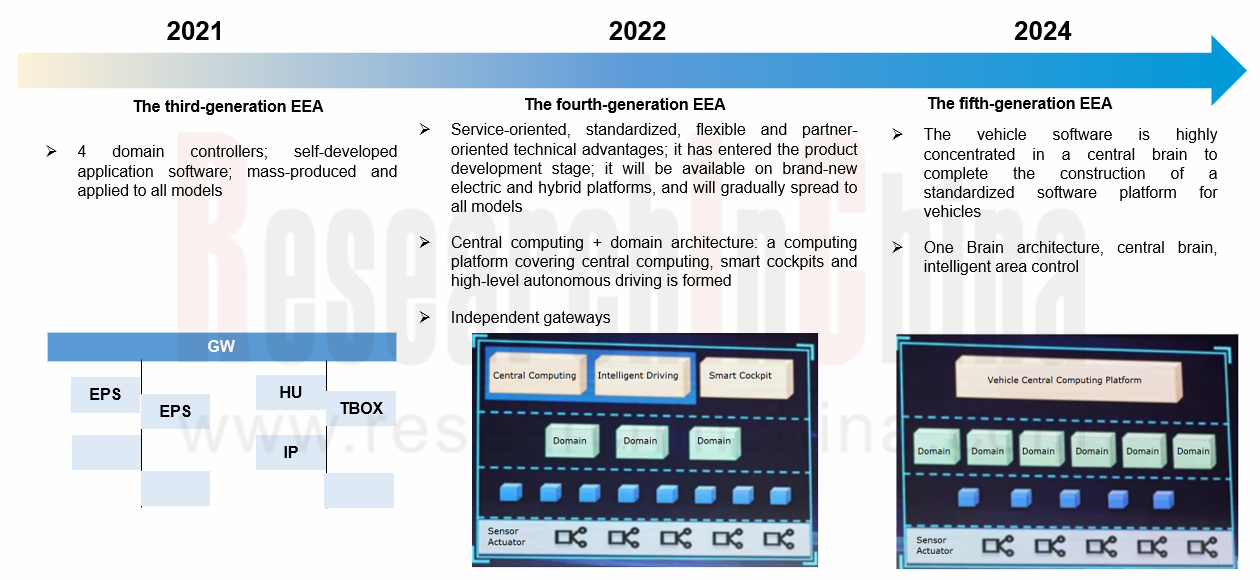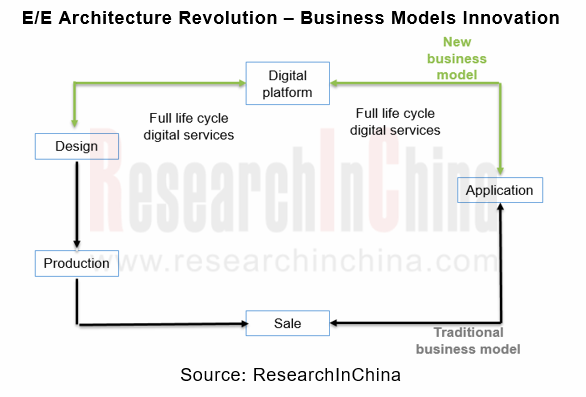Intelligent Vehicle E/E Architecture and Computing Platform Industry Research Report, 2021
E/E Architecture and Computing Platform Industry Research: Three Evolution Stages of Automakers’ E/E Architectures
Domain centralized architectures will gradually evolve to quasi-central and central computing architectures
The evolution of the brand-new automotive E/E architecture, which may take ten years, can be divided into three stages:
(1) Domain centralized architecture stage
At present, automakers mainly stay at the domain centralized architecture stage. For example, Volkswagen's E3 architecture, Great Wall’s GEEP3.0 architecture, BYD's E platform 3.0 architecture, Geely's SEA architecture, Xpeng's EE 2.0 architecture, etc. are all typical domain centralized architectures.
Automotive E/E architectures will inevitably develop towards centralized E/E architectures. From the perspective of mass-produced models, centralized E/E architectures prevail now, with domain control over power, chassis, body, intelligent driving and cockpit. However, it is difficult to fully realize standard domain architectures and central architectures due to technical thresholds, diversified configuration gradients, consumption habits and other factors, so the domain hybrid architecture of "distributed ECUs + domain controllers" will be common in the short term.
At present, Volkswagen, BMW, Geely ZEEKR, Huawei, Visteon, etc. adopt three-domain E/E architecture solutions which mainly include intelligent driving domain, intelligent cockpit domain, and vehicle controller domain.
Volkswagen has upgraded the MQB distributed E/E architecture to the MEB (E3) domain centralized E/E architecture which includes 3 domain controllers: vehicle control (ICAS1), intelligent driving (ICAS2), and intelligent cockpit (ICAS3). Modules such as chassis and airbags that do not have integration capabilities belong to ICAS1. At present, ICAS1 and ICAS3 have been developed and installed on ID.3, ID.4 and other models, while ICAS2 has not been developed yet.
In terms of the software architecture, E3 adopts a service-oriented architecture, using CP and AP service middleware to enable SOA communication; as for the communication architecture, E3's backbone network is Ethernet.
On the CC architecture, Huawei has launched three domain control platforms of intelligent cockpit (CDC), vehicle control (VDC), and intelligent driving (MDC) respectively, and released related open platforms and operating systems, such as the autonomous driving operating system AOS, the intelligent cockpit operating system HarmonyOS and the vehicle control operating system VOS.
In terms of communication architecture, the CC architecture has set up 3-5 VIUs (vehicle interface units). All actuators and sensors are connected to distributed gateways so as to form loops. Once a single loop fails to work, the other three loops maintain operation, hereby effectively improving safety.
(2) Quasi-central computing architecture stage
In the next step, automakers will work hard in the quasi-central architecture of “the central computing platform + regional controllers”. Through SOA, it shares the computing power of different domain controllers like a central computing platform. The GEEP 4.0 architecture to be launched by Great Wall in 2022 and the FEEA3.0 architecture (to be mass-produced in 2023) released by FAW Hongqi in 2021 are quasi-central architectures.
Tesla’s EEA architecture is the most advanced, at least 5 years ahead of that of traditional automakers. The E/E architecture of Model 3 has marked Tesla’s entry into the quasi-central architecture stage consisting of central computing module (CCM), Body Control Module Left (BCMLH) and Body Control Module Right (BCMRH), basically materializing the prototype of a centralized architecture with the self-developed Linux, FOTA of the whole vehicle and communication via the Ethernet backbone network.
Tesla's quasi-central E/E architecture has sparked a harness revolution. The wiring harness of Model S/Model X is as long as 3 kilometers, while Model 3 reduces the wiring harness length to 1.5 kilometers, and Model Y further shortens it to around 1 kilometer. Tesla's plans to make the length as short as 100 meters.
(3) Central computing architecture stage
From the perspective of development trends, the automotive E/E architecture will eventually evolve to the central computing architecture, concentrating the functional logic to a central controller. The OEM Great Wall plans to launch the central computing architecture GEEP 5.0 in 2024, and Changan also intends to complete the development of its central domain architecture in 2025.
Evolution of Automotive E/E Architecture

Source: ENOVATE
In the next 3-5 years, OEMs will focus on R&D and layout of quasi-central architectures
As per the E/E architecture solutions of traditional automakers, most OEMs at home and abroad have transferred from distributed architectures to domain centralized architectures, and they have taken quasi-central architectures as the focus of R&D and layout in the next 3-5 years. Quasi-central and centralized architectures can effectively reduce the number of controllers and wiring harnesses, promote the further decoupling of automotive hardware and software, and drag down the cost further. In order to keep up with the upgrades of automotive technology, OEMs speed up the deployment of quasi-central architectures, introduce SOA architectures and make layout in central computing platforms, etc..
Features of Next-generation E/E Architectures of Some OEMs

Source: ResearchInChina
Great Wall has independently developed the GEEP E/E architecture which has evolved to the third-generation GEEP 3.0 so far. As the domain control architecture, it boasts 4 domain controllers. With integrated software and hardware and self-developed application software, it has been successfully applied to all models. At present, Great Wall is actively developing the fourth- and fifth-generation E/E architectures.
As “the central computing platform + regional controllers” architecture, the fourth-generation E/E architecture of Great Wall comprises three large computing platforms for central computing, intelligent cockpit, and optional advanced autonomous driving respectively. The central computing platform integrates body, gateways, air conditioning, EV, power chassis and ADAS, featuring cross-domain integration. It is scheduled to be launched in 2022. The fifth-generation E/E architecture is to highly concentrate the entire automotive software in a central brain to achieve 100% SOA, and it will be available in 2024.
Evolution of Great Wall’s E/E Architecture

Source: ResearchInChina
The FEEA2.0E/E architecture developed by FAW Hongqi independently is a domain control architecture consisting of a new energy vehicle controller, a L3/L4 autopilot controller, and a central gateway controller. It has been mass-produced for E-HS9. FEEA3.0, a next-generation E/E architecture, was released in April 2021 as a quasi-central architecture of “the central computing platform + regional controllers”, reducing the number of controllers and the total length of the wiring harness by more than 50%, as well as adding. It is planned to be deployed on Hongqi EV-Concept in 2023.
Trends under new E/E architectures
As automotive E/E architectures gradually develop toward central architectures, the centralization of computing power, software services, and peripheralization of sensors and actuators tend to be more obvious; the industrial chain structure has been reshaped, and the business model has undergone significant changes.
(1) The supply chain system is reshaped
Under the traditional distributed E/E architecture, the hardware and algorithms of controllers are provided by Tier 1 suppliers and OEMs coordinate different suppliers, so that the collaboration is extremely inefficient.
Under the new E/E architecture, OEMs enjoy the dominance. Based on their own software and hardware platforms, they directly convey their demand to suppliers, among which Tier 1 suppliers are no longer dominant while Tier 0.5 suppliers emerge to provide algorithms and software for autonomous driving.

(2) The traditional "turnkey" model transfers to the "full stack" development model
OEMs manipulate the development of software platforms (covering functions integrated, suppliers, etc.) to accomplish deeper development. With the development of autonomous driving technology, OEMs are more inclined to carry out "full-stack" development: they gradually master E/E architectures, operating systems, core algorithms, cloud big data, chips and other capabilities, then provide sustainable and iterative product experience and services with a focus on smart scenarios and consumer experience.
(3) Business models are innovated, and the vehicle OTA sees the completed closed loop of business models
In addition, with the evolution of E/E architectures and the rapid development of vehicle OTA, the sales models of automobiles have altered accordingly. Automakers have turned from one-time product providers to “products + full life cycle services” providers. Around smart scenarios and consumer experience, they provide sustainable and iterative product experience and services. Emerging automakers represented by Tesla update software to iterate and upgrade vehicles.
In addition to vehicle sales, OEMs may charge software updates via OTA in the future. For example, the leader Tesla has earned more than USD1.2 billion from software updates.

Intelligent Vehicle E/E Architecture and Computing Platform Industry Research Report 2021 by ResearchInChina mainly studies the following:
 Overview, technology evolution trends, reform trends, market size, etc. of automotive E/E architectures;
Overview, technology evolution trends, reform trends, market size, etc. of automotive E/E architectures;
 Status quo, evolution trends, etc. of E/E architectures of major OEMs (emerging brands, independent brands, foreign brands);
Status quo, evolution trends, etc. of E/E architectures of major OEMs (emerging brands, independent brands, foreign brands);
 Status quo, planning, etc. of E/E architectures of major Tier 1 enterprises;
Status quo, planning, etc. of E/E architectures of major Tier 1 enterprises;
 Status quo of main E/E architectures (including computing architecture, software architecture, communication architecture, power management architecture, etc.);
Status quo of main E/E architectures (including computing architecture, software architecture, communication architecture, power management architecture, etc.);  Solutions of major manufacturers; evolution of new E/E architectures.
Solutions of major manufacturers; evolution of new E/E architectures.
New Energy Vehicle Thermal Management System Market Research Report,2022
Thermal Management Research: Technological Innovation and Iteration Have Spawned Emerging Markets
The rapid development of Chinese new energy vehicles has brought more opportunities for parts and com...
CTP, CTC and CTB Integrated Battery Industry Research Report, 2022
Integrated battery research: three trends of CTP, CTC and CTB
Basic concept of CTP, CTC and CTB
The traditional integration method of new energy vehicle power system is CTM, that is, "Cell to Module...
China Driving Recorder Market Research Report, 2022
Driving recorder research: sales volume of passenger cars equipped with OEM DVRs increased by 52.5% year-on-year in 2022 H1
In April 2021, the Ministry of Industry and Information Technology s...
Autonomous Delivery Vehicle Industry Report, 2022
Research on autonomous delivery: the cost declines, and the pace of penetration and deployment in scenarios accelerate.
Autonomous delivery contains outdoor autonomous delivery (including ground-base...
China Autonomous Heavy Truck Industry Report, 2022
Autonomous heavy truck research: entering operation and pre-installed mass production stage, dimension reduction and cost decrease are the industry solution
ResearchInChina released "China Autonomous...
China Smart Parking Industry Report, 2022
Smart parking research: there are 4,000 players, and city-level parking platforms have been established.
Smart parking market shows great potentials, and Baidu, Alibaba, Tencent and Huawei (BATH) hav...
Automotive Head-up Display (HUD) Industry Report, 2022
Automotive HUD research: AR HUD is being largely mounted on vehicles, and local suppliers lead the way. 1. AR HUD is being used widely, with 35,000 vehicles equipped in the first half of 2022.
S...
Intelligent Vehicle E/E Architecture Research Report, 2022
E/E architecture research: 14 key technologies, and innovative layout of 24 OEMsKey technologies of next-generation electronic and electrical architectures (EEA)
The definition of next-generation E/E...
China Automotive Lighting Market Research Report, 2022
Automotive lighting research: the penetration of ambient lights has reached 31%, and intelligent lighting is reshaping the third living space.
Favorable policies and consumption upgrade help automake...
Global and China Automotive IGBT and SiC Research Report, 2022
1. In 2025, China's automotive SiC market will be valued at RMB12.99 billion, sustaining AAGRs of 97.2%.
Silicon carbide (SiC) devices that feature the resistance to high voltage and high frequency ...
Passenger Car Chassis Domain Controller Industry Report, 2022
Chassis domain controller research: full-stack independent development, or open ecosystem route?
Chassis domain consists of transmission, driving, steering and braking systems. Conventional vehicle ...
China Automotive LiDAR Industry Research Report, 2022
LiDAR research: Chinese passenger cars will carry over 80,000 LiDAR sensors in 2022
1. The mass production of LiDAR is accelerating, and the installations are expected to exceed 80,000 units in 2022
...
China Autonomous Driving Data Closed Loop Research Report, 2022
1. The development of autonomous driving is gradually driven by data rather than technology
Today, autonomous driving sensor solutions and computing platforms have become increasingly homogeneous, an...
Overseas LiDAR Industry Research Report, 2022
LiDAR Research: Perception Algorithms Become the Layout Focus of Foreign Vendors
Amid a variety of technology routes in parallel, rotating mirror and flash solutions are adopted most widely during OE...
Smart Car OTA Industry Research Report, 2022
Smart car OTA research: With the arrival of OTA3.0 era, how can OEMs explore payment modes of SAAS?
Driven by the development of smart cars, China's OTA installation rate has been growing. According ...
Chinese Joint Venture OEMs’ ADAS and Autonomous Driving Report, 2022
Joint Venture OEM's ADAS Research: Joint venture brands lead in L2/L2.5 installation rate, but have not involved L2.9 for the time being
Following "Chinese Independent OEMs’ ADAS and Autonomous Drivi...
Global and China Hybrid Electric Vehicle Research Report, 2022
Hybrid Research: China Hybrid EV penetration rate will hit 22% within five years
With the development of automobile energy-saving and new energy technologies and the promotion of low-carbon emission ...
China Smart-Road Roadside Perception Industry Report, 2022
Top 10 roadside perception suppliers: quality suppliers come to the front in each market segment.
The growing number of roadside perception players comes with active industrial investment and financ...